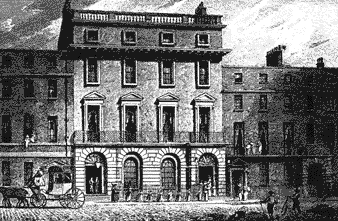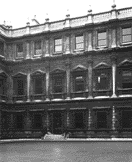Burlington House
A Brief History

The 'Astronomical Society of London' was conceived on 12 January 1820 when 14 gentlemen sat down to dinner at the Freemason's Tavern, in Lincoln's Inn Fields, London. After an unusually short gestation the new Society was born on 10 March 1820 with the first meeting of the Council and the Society as a whole. An early setback, when Sir Joseph Banks induced the Duke of Somerset to withdraw his agreement to be the first President, was overcome when Sir William Herschel agreed to be the titular first President, though he never actually took the Chair at a meeting.
The original objectives were simply the promotion of astronomy; the newer subject of geophysics, which had been steadily gaining ground in the interests of the Fellows, was added later. After much negotiation a Royal Charter was signed by William IV on 7 March 1831, and the Society assumed the name it has used ever since. William IV also agreed to be the Society's Patron; every subsequent monarch has followed suit. Since this time a set of bye-laws have been established which govern the running of the Society.

(© RAS)
From the early years meetings were held where astronomical research and discussion could be aired. The Society at first met in various locations, including the rooms of the Geological Society, then in Bedford St, Covent Garden. Rooms were subsequently rented, for 50 guineas, from the Medical and Chirurgical (i.e. surgical) Society at 57 Lincoln's Inn Fields, which sufficed until 1834, when the government provided accommodation in Somerset House, in the Strand: 7 (later 8) rooms were made available for the Society. In 1874 the Society moved to specially built premises in part of Burlington House, Piccadilly, which it has occupied ever since. The first meeting in this new home was held on 13 November 1874.
Library
From its earliest days the Society had started to accumulate books, manuscripts, instruments and other memorabilia, and these formed the basis of the Library and Archives which are maintained today. Some items were later disposed of, mainly to save space, and the Instrument collection was severely rationalized in the 1970s, many items being donated or lent to Museums; but a small number were retained for display on the Burlington House premises. The current Library collection includes about 35,000 bound items, including about 14,000 open-shelf books published after 1850, about 3,500 before that date, and the remainder bound journals, together with a large collection of unbound pamphlets.
The Archives include a range of observational and other material dating mainly from 18th, 19th and 20th centuries, with some older; much the most important group is the Herschel Archives. As well as private donations such as the magnificent Grove Hills collection, bequeathed in 1923, a major accession to the Library took place in 1846 when the RAS absorbed the Spitalfields Mathematical Society, started in 1717 by the Huguenot silk-weavers in Spitalfields, east London.
Publications
Publications formed a central activity from the very beginning, the Memoirs of the RAS starting in 1822 (though this series was discontinued in 1978). The Monthly Notices started in 1827, and this series continues to this day as the Society's flagship astronomy journal; it is currently published three times a month (and, to belie its title further, no longer contains Society notices).
Geophysical publication has been a major success story of the RAS, starting with a Geophysical Supplement to MN which was published from 1922 to 1957, becoming the fully fledged Geophysical Journal in 1958. This has subsequently merged with two European journals to become Geophysical Journal International.
The Quarterly Journal was started in 1960 and was published until 1996, providing a home for more general articles, speculative researches, obituaries and historical articles; this was replaced by the new title, Astronomy & Geophysics, in 1997, providing a full-colour 'glossy', but still refereed, journal of news and reviews to the Fellowship.
In 1970 the Society's 150th anniversary was marked with the issue of a commemorative postage stamp.
Amateurs and professionals
When the Society was started there were very few professional astronomers, but by the end of the 19th century there were many more. To cater for the growing enthusiasm for amateur astronomy the British Astronomical Association was started in 1890 and now has only a slightly smaller membership than the RAS. Entering the 21st century the Society continues to carry out its three main functions of maintaining a Library, organizing scientific meetings, and publishing journals, but now performs many other functions in pursuit of its goals of the encouragement and promotion of astronomy and geophysics.
P. D. Hingley
More information
- The Society's history is recorded in detail in two volumes, available for purchase in hardback and in paperback. Volume 1 covers 1820 to 1920, and volume 2 1920 to 1980.
- A virtual tour of the Burlington House apartments is available.
- The Royal Charter is available online.
- A list of past Presidents is here.
- An index of Obituaries of RAS Fellows and Associates published in the Society's journals will be available online soon, as are lists of medallists and prizewinners.
- Further historical information on Burlington House is provided by the Royal Society, who are previous occupants, and the Royal Academy, who now occupy the north wing of the courtyard. In addition there is an entry on Wikipedia at http://en.wikipedia.org/wiki/Burlington_House.
RAS Dining Club
Several early scientific societies in Britain had their origins as a dining club, when travel was more difficult than now and an overnight stay was convenient after a meeting at which its members would discuss the latest scientific results. The Royal Astronomical Society conceived on 12 January 1820 by 14 astronomers at such a dinner at the Freemason's Tavern, in Lincoln's Inn Fields, London, first met for its scientific business two months later on 10 March 1820. Since then, the RAS Club has continued solely as a social club which meets for dinner following the organised scientific meetings.
Since their beginnings the Dining Club and the Society have enjoyed completely separate financial and organisational existences, though Fellowship of the latter is a condition for membership of the former. Also, at the friendly offer of the Club, the Society invites those guest speakers and medallists whom it hosts in London at the scientific meetings to dine with the Club if they wish (or offers expenses to dine in a restaurant if not). The Club has a membership of about 60, most of whom dine regularly, plus about 30 'Honorary Members' who, for one reason or another, are unable to do so. Members may also (normally) invite one guest. Members of Council may also dine, ex-officio, at any time at their own expense. Up to four new members are elected each year. For further information about the Dining Club please mjp@ast.cam.ac.uk Margaret Penston.

